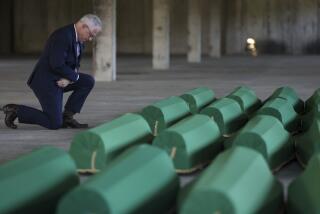Croats, Serbs Capitalize on Horror Stories : Nationalist leaders are using pictures and tales of past atrocities to stoke fear and hatred.
- Share via
BELGRADE, Yugoslavia — The book is entitled “Never Again,” and its glossy cover shows Croatian fascists posing for the camera as they hold down a struggling Serb prisoner and prepare to saw off his head.
Other chilling photographs in the 80-page publication of the Serbian government depict concentration camp inmates bound in barbed wire, decapitated bodies arranged in grotesque formations and Croatian officers standing triumphantly over trenches filled with the corpses of their victims.
The grisly photographs are 50 years old, but such official publications have so proliferated in Serbian bookshops and sidewalk kiosks that they have taken on new power to instill hatred of the Croats.
Repeatedly exposed to the scenes of horror, many Serbs heed their leaders’ warnings of impending genocide if rival Croatia becomes an independent state.
Croatian officials churn out similar gory evidence of atrocities against their people, both the postwar retaliation killings of those accused of collaborating with the Nazis and photos of more recent slayings in Croatia’s nearly four-month war to break free of Yugoslavia.
Such graphic presentation of the horrors Yugoslav peoples have inflicted on each other were unimaginable during four decades of communism, when Marshal Josip Broz Tito enforced Serb-Croat unity and punished nationalist efforts to shed light on the federation’s terrible past.
But the long silence has only enhanced the propaganda value of the gruesome pictures.
Both nationalist leaderships have trumpeted their suffering to stoke fears and hatred to propel the current conflict, transforming their peoples’ agony into new and stronger determination to settle the score.
With both hate campaigns now in full fury, the fighting in Croatia that has already claimed more than 1,000 lives threatens to become a self-fulfilling prophecy by repeating the past war’s most unspeakable crimes.
“They are bringing out the monster in each other,” said a Western diplomat in this federal and Serbian capital.
Even academics aligned with their own nationality contend that only more tragedy will come of baring the old wounds.
“I don’t agree with all this revisiting of the past. It’s too much,” said Milorad Ekmecic, a prominent Serbian historian whose family was wiped out by Croatian fascists in 1941. “We need to forgive the Croats for what they did to us during the war. But to forgive them, they must repent.”
Zagreb is loathe to apologize, although it insists that the Croatia of today is not that of World War II.
Reactionaries in both republics make sure the last war’s ghosts are never far from view.
A handful of men dressed in fascist Ustasha regalia stroll the streets of Zagreb, unhindered by police or laws against ethnic incitement.
The radical right-wing Croatian Party of Rights displays a map at its public headquarters showing the expanded Croatia of the 1940s and a sketch of Ante Pavelic, leader of Croatia’s quisling government under Nazi Germany.
Serbian Chetniks--successors of the royalist warriors who fought both the Ustasha and the Communists in the last war--strut through Belgrade cafes, boasting of their role in the recent slaughter.
Kiosks in both capitals sell virulently nationalist literature and wartime paraphernalia.
The tit-for-tat antagonism has prompted new claims of war crimes by both sides, as well as the eruption of propaganda that feeds Serb-Croat hate.
Those producing the materials see their cause as just.
“We have to make people aware of why the Serbs in Croatia have such fear, to make it understood that Serbs endured so much during the last war, during World War II, that they can never again be faced with such a threat,” said Julijana Fatic, an aide to Serbian Information Ministry editor Nebojsa Jerkovic, who published “Never Again.”
The latest official counterattack from Zagreb, “War Crimes Against Croatia,” matches the Serbian gore and doubles the quantity.
Special correspondent Danica Kirka in Zagreb, Croatia, contributed to this article.
More to Read
Sign up for Essential California
The most important California stories and recommendations in your inbox every morning.
You may occasionally receive promotional content from the Los Angeles Times.














